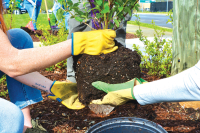Notes from a plant nerd: A jewel among wildflowers
Among my favorite plants to teach to children is jewelweed (Impatiens capensis & I. pallida).
There are so many fun and interesting features of this plant that it seems a crime to label it with the negative sounding “weed” designation. Sure, it reseeds itself all around, and grows where no human has planted it. But the word has such negative connotations, especially those referencing weeds as bad and in need of removal.
And these species certainly are not bad and do not need to be weeded out. They are among the most useful, fun and beautiful native plants. I get really impatient waiting on the jewelweed flowers to bloom, and so do the hummingbirds and bumblebees who love feeding on this plant’s nectar.
It is an annual plant, meaning it grows brand new each year from seed, makes leaves, flowers and then fruits in that same year. Then it spreads its seeds around before dying completely at the first frost in the fall. In spring, the newly emerging seedlings look like little green butterflies when their first seed leaves, or cotyledons emerge from the soil.
The flowers of jewelweed are orange in the Impatiens capensis species, which is also called spotted jewelweed. Impatiens pallida, or pale jewelweed, mostly have yellow flowers. Pale jewelweed can also come in a white form, and a version that has white and yellow blossoms. Both species will grow 2 to 5 feet tall, with smooth succulent stems that are juicy when crushed.
That juicy sap contained within jewelweed is an incredible medicine that makes jewelweed a very important plant to keep around. Jewelweed juice will alleviate most any itchy skin conditions. It will also take away the sting of stinging nettle (Urtica dioica) and wood nettle (Laportea canadensis). And probably its most helpful use is that the stems and juicy sap of jewelweed is both cure and prevention for poison ivy (Toxicodendron radicans).
Related Items
If you know you are going to be in contact with poison ivy, if you accidentally touch some, or if you find yourself breaking out with a rash from poison ivy, go find jewelweed, crush up the stems and leaves until it is juicy, and rub it gently over any exposed areas of your skin and you won’t be bothered by poison ivy, or it will relieve the itchiness if you have already broken out. This used to be considered an “old wives’ tale,” but some recent research has proven what many people have known for years, including the Cherokee and other Southeastern Native People, that jewelweed is both prevention and cure for poison ivy.
Another common name for jewelweed is silver leaf, due to the tiny hairs on their leaves which refract sunlight silver when there is water on the leaf, like dew or raindrops. And you can use this quality of the pant to perform a magic trick that will make you the hit at your friend’s parties, or at least with their kids. If you put a leaf of jewelweed underwater in sunlight and gently move it around, it will look silvery and metallic like tin foil.
And the fun doesn’t stop there, as jewelweed has yet another common name of touch-me-not which comes from their particular method of seed dispersal. While some plants use animals or wind or gravity to spread their seeds around, jewelweed uses what is called ballistic seed dispersal. That’s right — they have exploding seed pods that launch the seeds far and wide when they are ripe. It’s so much fun and relaxing to pop these seedheads and watch them explode, that I like calling them “nature’s bubble wrap.”
It’s also where the genus name of Impatiens comes from, as the seeds are so impatient to get out of the pod that they can’t wait and will blow up at the slightest touch. And while this is not necessarily a good quality in people, it makes for a fun and exciting way to pass the afternoon.
(Adam Bigelow lives in Cullowhee and leads weekly wildflower walks most Fridays and offers consultations and private group tours through Bigelow’s Botanical Excursions. This email address is being protected from spambots. You need JavaScript enabled to view it..)









